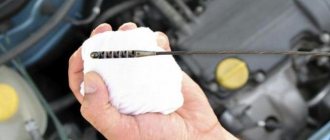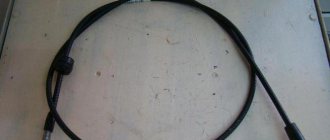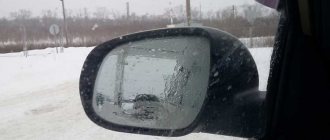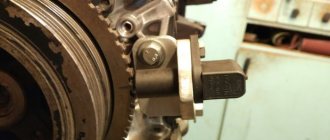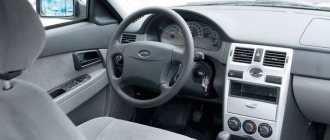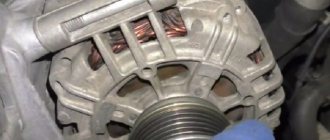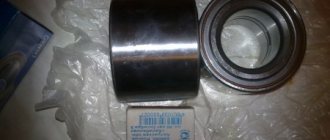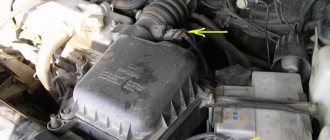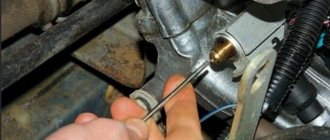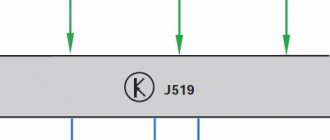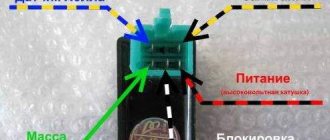Parktronic is a necessary and important assistant for beginners and experienced car enthusiasts. The system helps to avoid collisions with obstacles when performing a parking maneuver. Very often, novice car enthusiasts do not notice bollards, high curbs and other obstacles when reversing.
In order to protect drivers from ridiculous accidents, there are parking sensors or parking radars. These are electronic devices and periodically they fail for various reasons.
A classic example of parking sensors is an almost complete copy of a radar developed at the beginning of the 20th century. The transmitter generates an ultrasonic pulse directly into the sky, then the signal is reflected from the aircraft, then the electronics calculate the time for it to travel there and back. Based on the speed of wave propagation in the air, the distance to the object can be calculated.
Simpler devices work on the basis of this principle - an echo sounder for fishing, as well as parking sensors for motorists.
Basic parking sensor malfunctions
Among the main malfunctions of devices are:
Marriage . This is a common thing, especially considering that the bulk of the offerings on the market are made in China. This problem can only be solved by returning the parking sensors to the seller or manufacturer;
Malfunctions with wiring , sensors or tape at the points where it is mounted to the bumper;
Control unit malfunctions are a fairly rare problem. The control units of high-quality parking sensors are equipped with their own diagnostic system and if there is a problem, the driver will definitely receive a message or some kind of signal;
Problems with sensors or tape due to the adhesion of dirt, dust, or moisture. Ultrasonic sensors can be damaged by even minor rock impacts.
The tape requires constant cleaning for which it must be dismantled. The ultrasonic sensor is not particularly afraid of dirt and humidity. But moisture tends to accumulate and then disables the element;
control unit most often fails due to dirt and water. Short circuits are often diagnosed during autopsy;
Another problem is the wiring .
The problem is quite rare. This can happen during the process of installing the system on the car.
How to avoid parking sensor breakdowns
The likelihood of damage to the car when driving in a confined space depends on the correct operation of the parking sensors. Accordingly, it is important to follow simple rules in order to always be confident that the system is working:
Be sure to clean the sensors from dirt and moisture, it is especially important to do this on a regular basis during precipitation and when there is slush on the roads;- If you have electromagnetic parking sensors installed, then check the tape for contamination and defects. It is important to note that the tape should be completely cleaned of dirt - from the inside and outside. Don’t forget to remove and inspect it regularly;
- From time to time, clean the control unit from dust, but do it carefully so as not to damage the components of the device's printed circuit board.
It should be remembered that the correct operation of the parking sensors largely depends on its correct installation. Make sure that the sensors do not “dangle”, and if the bumper is damaged, be sure to diagnose them to make sure that they are not damaged.
( 399 votes, average: 4.56 out of 5)
Water in the muffler: how it gets in and what the danger is
How to check a ball joint and determine the malfunction
Related Posts
Diagnostics and repair methods
The main function of the parking radar is to inform the driver about an obstacle behind or in front of the car.
If the device does not produce any signals or produces signals with errors, you need to understand the reasons and eliminate them, but first you should carry out a comprehensive diagnosis.
Sensor check
If the radar worked before, but suddenly stopped, the first thing to do is check the condition of the ultrasonic sensors - they may be dirty or dusty. When cleaning sensors, pay attention not only to the elements themselves, but also to the installation point. It is important that the sensor mount is secure.
If cleaning does not produce results, then you should make sure that the elements are in good condition. Checking this is quite simple - the driver needs to turn on the ignition and then touch each sensor with a finger. If the sensor is working, it will vibrate and crackle. If nothing crackles when touched with a finger, then the sensor is replaced with a new one. Sometimes sensors can be repaired.
If you can use your finger to determine which of the sensors on the bumper is not working, then before taking more serious action, you should dry the element thoroughly. Sometimes, after thorough drying, the sensors begin to work. If this does not happen, then you can check the element with a multimeter.
Related article: All ways to turn off the alarm in a car without a key fob
The sensor has electrical contacts - some models have two and some have three contacts. The left one on most elements is “mass”. The tester is switched to resistance measurement mode. One probe is connected to ground, and the second to the second contact.
If the device shows that the resistance is greater than zero and not equal to infinity, then the sensor is in working condition. In all other cases, the sensor is faulty and requires replacement.
You can also check the wiring using a multimeter. To do this, check all the wires that connect the sensor to the control unit. If a break or other faults in the electrical circuit are found, then the wiring for a specific sensor needs to be replaced.
Control unit diagnostics
The unit is reliably protected from moisture and dirt and very rarely fails - it is installed inside the car, and all wiring from the sensors is connected to it using wires or wirelessly.
If problems occur, you can remove the printed circuit board and visually diagnose it - if damaged capacitors or resistors are visible, they can be easily replaced with available analogues.
Checking the metallized strip of the parking radar
As for metallized tapes, everything is much simpler. The tape has a simple, if not primitive, device - malfunctions can only occur due to physical damage.
The entire diagnostic process comes down to a thorough visual inspection. You need to pay attention to even minor defects - scratches, cracks.
Note: Lambda probe, what is it, signs of malfunction and methods of checking
If the integrity of the tape is not broken, then it is recommended to look for the causes of the malfunction anywhere, since the tape has nothing to do with it.
Selecting parking sensors
If parking sensors are not included in the vehicle, when purchasing the device you need to pay attention to the following characteristics:
- Installation location. Parking sensors can be built into the rear bumper; it turns on when you reverse. The devices installed at the front of the vehicle are activated when the speed decreases. Combined systems consist of sensors mounted on both bumpers.
- Notification method. When obstacles are detected, a sound indication may sound. More complex systems are equipped with a display on which color signals appear when approaching objects. If the parking sensor is equipped with a camera, the image is sent to a monitor built into the mirror or dashboard. Some devices combine several notification methods.
- Sensor sensitivity. The correctness of calculating the distance to objects depends on this parameter.
- Number of sensors. The system must include at least 4 sensors. Reducing the number of these parts creates blind spots, increasing the risk of colliding with an obstacle.
- Installation method. The sensors can be embedded into holes drilled in the bumper. There are also overhead models.
- Sensor color. Most parking sensors are available in various color options. If the car has a rare shade, the sensors can be painted. When the work is done correctly, the quality of signal transmission does not deteriorate.
- Display type. The screen can be LED or LCD. Each type has its own positive and negative qualities, so the choice is up to the user.
- Protection from dust and moisture. The ability to operate the system in conditions of high humidity and pollution depends on this indicator.
- Automatic fault detection function. The system notifies the user in a timely manner when problems occur. This helps save money spent on repairs.
Why is the parking sensor not working?
As you can see from the parking sensor design described above, such a radar is a very simple device that consists of a minimum number of components. Accordingly, there cannot be many reasons for the parking sensor malfunction. The following are the main reasons why the parking sensors do not work:
- Pinched or broken wires. As mentioned above, parking sensors can interact wired or wireless. When the system operates through wires, there is a high risk of them breaking or pinching, which will cause problems with the system’s performance;
- Incorrect sensor mounting. Another common problem is a loose sensor or metallized tape. If the sensors are not directed towards obstacles, the parking sensors will not be able to work correctly. It is important to note that the sensors should not swing when the car is moving, otherwise they will also distort the results;
- Marriage. No electronic device is protected from manufacturing defects. Since several elements are involved in the parking sensors, the failure of one of them will affect the operation of the system as a whole. The system itself most often notifies the driver of a malfunction, while it is much more difficult to find out about the failure of the sensor;
- Dirt and moisture. If we consider the reasons why the parking sensors do not work, we cannot fail to mention such as contamination or splashing of the sensors. If the sensors are dirty or exposed to water, they may not work properly. That is why it is recommended to carefully choose the place for mounting the parking sensors so that when the car is moving, a random stone does not “fly” into them, water does not get into them during rain, and when driving through puddles, dirt does not settle on them;
- Short circuit of the “brain” of the system. The parking sensors are also not protected from banal electrical problems. There is always a possibility that a short circuit will occur in the printed circuit board of the “brain” of the system, for example, the cause of which may be contamination of the board or operation at high temperatures. Determining the failure of the parking sensor “brain” is not difficult.
Article on the topic: Atmospheric power unit
Above are the main reasons why the parking sensors do not work. As you can see, they are quite commonplace and do not differ much from the causes of malfunction of other electronic equipment in the car.
How to connect
The parking sensor connection process includes the following steps:
- Display connection. The cable is fixed to the dashboard using double-sided tape. The wire is laid on the left side of the cabin towards the trunk. You can make the job easier by attaching thick wire to the ends of the cables.
- Connecting the parking sensor unit. The element is attached to the body using double-sided adhesive tape. Sensor and display cables are connected to its connectors. To prevent the wires from coming into contact with metal parts of the car and creating extraneous sounds, they are tightened with clamps.
- Power connection. The red cable leading to the control unit is twisted with the green cable of the reversing light. It is recommended to make connections using special terminals. The ground wire is attached to the seat belt latch.
After completing the installation work, check the correct connection. If no faults are found, the installation was completed correctly.
